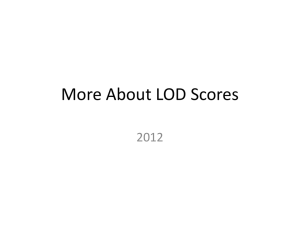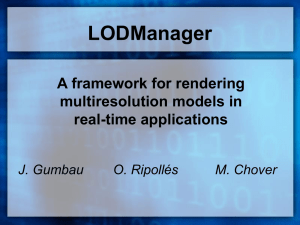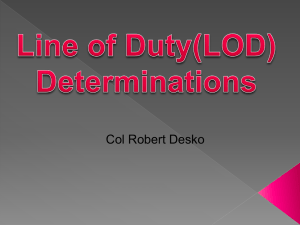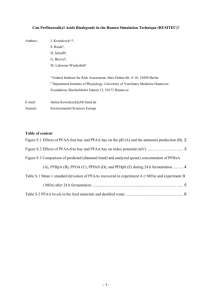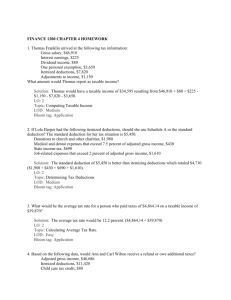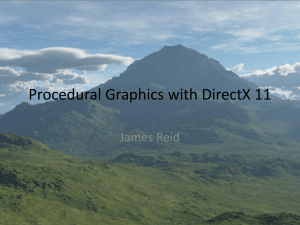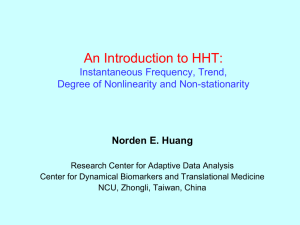True/False Questions
advertisement
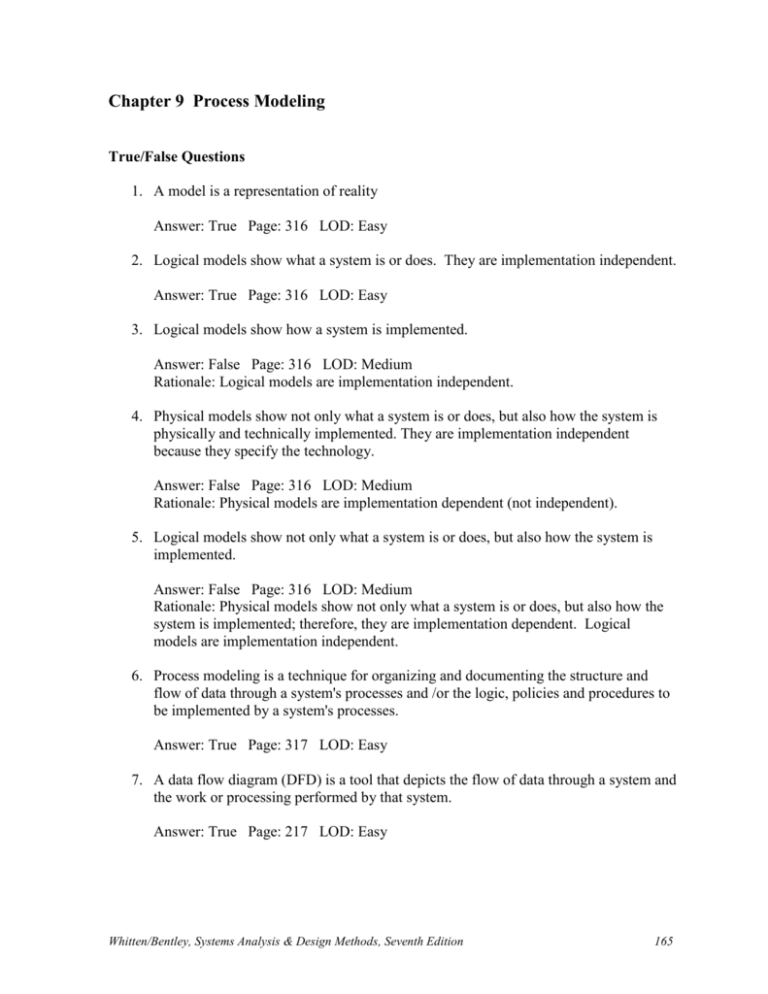
Chapter 9 Process Modeling True/False Questions 1. A model is a representation of reality Answer: True Page: 316 LOD: Easy 2. Logical models show what a system is or does. They are implementation independent. Answer: True Page: 316 LOD: Easy 3. Logical models show how a system is implemented. Answer: False Page: 316 LOD: Medium Rationale: Logical models are implementation independent. 4. Physical models show not only what a system is or does, but also how the system is physically and technically implemented. They are implementation independent because they specify the technology. Answer: False Page: 316 LOD: Medium Rationale: Physical models are implementation dependent (not independent). 5. Logical models show not only what a system is or does, but also how the system is implemented. Answer: False Page: 316 LOD: Medium Rationale: Physical models show not only what a system is or does, but also how the system is implemented; therefore, they are implementation dependent. Logical models are implementation independent. 6. Process modeling is a technique for organizing and documenting the structure and flow of data through a system's processes and /or the logic, policies and procedures to be implemented by a system's processes. Answer: True Page: 317 LOD: Easy 7. A data flow diagram (DFD) is a tool that depicts the flow of data through a system and the work or processing performed by that system. Answer: True Page: 217 LOD: Easy Whitten/Bentley, Systems Analysis & Design Methods, Seventh Edition 165 Chapter 9 Process Modeling 8. An entity relationship diagram (ERD) is a tool that depicts the flow of data through a system and the work or processing performed by that system. Answer: False Page: 317 LOD: Medium Rationale: A data flow diagram (DFD) is a tool that depicts the flow of data through a system and the work or processing performed by that system. The DFD is a representation of the process model. An entity relationship diagram (ERD) is a representation of the data model. 9. A data flow diagram is a process model. Answer: True Page: 317 LOD: Easy 10. Another name for the data flow diagram is an entity relationship diagram. Answer: False Page: 317 LOD: Medium Rationale: Another name for the data flow diagram is process model. 11. In a data flow diagram, rounded rectangles are used to represent processes. Answer: True Page: 321 LOD: Easy 12. In a data flow diagram, squares are used to represent external agents – the boundary of the system. Answer: True Page: 319 LOD: Easy 13. In a data flow diagram, rounded rectangles are used to represent external agents – the boundary of the system. Answer: False Page: 319 LOD: Medium Rationale: In DFDs, rounded rectangles are processes and squares are external agents. 14. Data flow diagrams have found new use in business process redesign. Answer: True Page: 319 LOD: Medium 15. A process is work performed on, or in response to, incoming data flows or conditions. A synonym is transform. Answer: True Page: 322 LOD: Easy 166 Whitten/Bentley, Systems Analysis & Design Methods, Seventh Edition Chapter 9 Process Modeling 16. Data describe work to be performed on, or in response to, incoming process flows or conditions. Answer: False Page: 322 LOD: Medium Rationale: A process is work performed on, or in response to, incoming data flows or conditions. 17. In data flow diagrams, open-ended boxes represent data stores. Answer: True Page: 320 LOD: Easy 18. In data flow diagrams, open-ended boxes represent external agents. Answer: False Page: 320 LOD: Medium Rationale: Open-ended boxes are used for data stores and squares are used for external agents. 19. In data flow diagrams, arrows represent data flows. Answer: True Page: 325 LOD: Easy 20. A system is a process. Answer: True Page: 321 LOD: Easy 21. If data modeling is done before process modeling, the agents on the DFD can be pulled from the entity relationship diagram. Answer: False Page: 320 LOD: Medium Rationale: Data stores can be pulled from the entities on the entity relationship diagram. 22. The use of logical models reduces the risk of missing business requirements. Answer: True Page: 316 LOD: Medium 23. Data Flow Diagrams are a kind of flowchart. Answer: False Page: 317 LOD: Medium Rationale: Flowcharts show the sequence of processes in an algorithm, while dFDs show the flow of data through the system. Whitten/Bentley, Systems Analysis & Design Methods, Seventh Edition 167 Chapter 9 Process Modeling 24. A complex system is usually easy to understand when viewed as a whole. Answer: False Page: 322 LOD: Medium Rationale: A complex system is usually difficult to understand when viewed as a whole. 25. Decomposition is the act of breaking a system into component subsystems, processes and subprocesses. Answer: True Page: 322 LOD: Easy 26. During decomposition, each level of abstraction reveals more or less detail as desired, about the overall system or a subset of that system Answer: True Page: 322 LOD: Easy 27. In systems analysis, decomposition allows you to partition a system into logical subsystems of processes for improved communication, analysis and design. Answer: True Page: 322 LOD: Easy 28. A decomposition diagram is also called a hierarchy chart. Answer: True Page: 323 LOD: Easy 29. A data flow diagram shows the top down functional decomposition and structure of a system. Answer: False Page: 323 LOD: Medium Rationale: A decomposition diagram shows the top down functional decomposition and structure of a system. 30. A decomposition diagram is a tool that depicts the flow of data through a system and the work or processing performed by that system. Answer: False Page: 317, 323 LOD: Medium Rationale: A data flow diagram is a tool that depicts the flow of data through a system and the work or processing performed by that system. A decomposition diagram shows the top down functional decomposition and structure of a system. 31. A hierarchy chart is another name for a decomposition diagram. Answer: True Page: 323 LOD: Easy 168 Whitten/Bentley, Systems Analysis & Design Methods, Seventh Edition Chapter 9 Process Modeling 32. A decomposition diagram is essentially a planning tool for more detailed process models, namely, data flow diagrams. Answer: True Page: 323-324 LOD: Easy 33. Logical processes are work or actions that must be performed no matter how you implement the systems. Answer: True Page: 324 LOD: Easy 34. Physical processes are work or actions that must be performed no matter how you implement the systems. Answer: False Page: 324 LOD: Medium Rationale: Logical processes are work or actions that must be performed no matter how you implement the systems. 35. Each logical process must be implemented in software. Answer: False Page: 324 LOD: Medium Rationale: Each logical process is (or will be) implemented as one or more physical processes that may include work performed by people; work performed by robots or machines; or work performed by computer software. 36. A function is a set of related and ongoing activities of the business. Answer: True Page: 324 LOD: Easy 37. An event is a logical unit of work that must be completed as a whole. Answer: True Page: 324 LOD: Easy 38. An event is a logical unit of work that can be completed in parts over time. Answer: False Page: 324 LOD: Easy Rationale: An event is a logical unit of work that must be completed as a whole. 39. An event is triggered by a discrete input and is completed when the process has responded with the appropriate outputs. Answer: True Page: 324 LOD: Easy Whitten/Bentley, Systems Analysis & Design Methods, Seventh Edition 169 Chapter 9 Process Modeling 40. An event is triggered by a discrete output that is completed when the process has responded with the appropriate inputs. Answer: False Page: 324 LOD: Medium Rationale: An event is triggered by a discrete input and is completed when the process has responded with the appropriate outputs. 41. Events are sometimes called transactions. Answer: True Page: 324 LOD: Easy 42. A function is a unit of work that must be completed as a unit or whole. Answer: False Page: 324 LOD: Medium Rationale: A function is a set of related and ongoing activities with no start or end; while an event is a unit of work that must be completed as a whole and has a start and end. 43. Elementary processes are discrete, detailed activities or tasks required to complete the response to an event. Answer: True Page: 325 LOD: Easy 44. Elementary processes are the overall activities to be accomplished by a system. Answer: False Page: 325 LOD: Medium Rationale: Elementary processes are discrete, detailed activities or tasks required to complete the response to an event. 45. Elementary processes are at the highest level of detail when depicted in a process model. Answer: False Page: 325 LOD: Medium Rationale: Elementary processes are the lowest level of detail when depicted in a process model. 46. Elementary processes are the lowest level of detail when depicted in a process model. Answer: True Page: 325 LOD: Easy 47. Primitive processes are the lowest level of detail when depicted in a process model. Answer: True Page: 325 LOD: Medium 170 Whitten/Bentley, Systems Analysis & Design Methods, Seventh Edition Chapter 9 Process Modeling 48. A black hole is a process that has inputs but no outputs. Answer: True Page: 325 LOD: Easy 49. A black hole is an acceptable elementary process. Answer: False Page: 325 LOD: Medium Rationale: A black hole is an incomplete specification of a process; it has only inputs but no outputs. 50. Gray holes can be caused by a misnamed process. Answer: True Page: 325 LOD: Easy 51. A gray hole is a process where the inputs are insufficient to produce the desired outputs. Answer: True Page: 325 LOD: Easy 52. A data store represents data in motion. Answer: False Page: 325 LOD: Medium Rationale: A data flow is data in motion. 53. A logical process can perform computations. Answer: True Page: 325 LOD: Easy 54. A logical process can make decisions. Answer: True Page: 325 LOD: Easy 55. A logical process can trigger other processes. Answer: True Page: 325 LOD: Easy 56. A logical process can use stored data to create, read, update or delete a record. Answer: True Page: 325 LOD: Easy Whitten/Bentley, Systems Analysis & Design Methods, Seventh Edition 171 Chapter 9 Process Modeling 57. Structured English is a language and syntax, based on the relative strengths of structured programming and natural English, for specifying the underlying logic of elementary processes on process models such as data flow diagrams. Answer: True Page: 353 LOD: Easy 58. An iteration structure specifies that a set of steps should be repeated based on some stated condition. Answer: True Page: 355 LOD: Easy 59. A repetition structure specifies that a set of steps should be repeated based on some stated condition. Answer: True Page: 355 LOD: Easy 60. A conditional structure specifies that a set of steps should be repeated based on some stated condition. Answer: False Page: 355 LOD: Medium Rationale: A conditional structure specifies that a process must perform different steps under well-specified conditions. A repetition or iteration structure specifies that a set of steps should be repeated based on some stated condition. 61. A conditional structure specifies that a process must perform different steps under well-specified conditions. Answer: True Page: 355 LOD: Easy 62. A function is a set of related and ongoing activities of the business. Answer: True Page: 324 LOD: Easy 63. A restriction of Structured English is that only strong, imperative verbs may be used. Answer: True Page: 355 LOD: Easy 64. A restriction of Structured English is that only names that have been defined in the project dictionary may be used. Answer: True Page: 355 LOD: Easy 172 Whitten/Bentley, Systems Analysis & Design Methods, Seventh Edition Chapter 9 Process Modeling 65. Structured English allows the analyst to define new terms as the process is being defined. Answer: False Page: 355 LOD: Medium Rationale: A restriction of Structured English is that only names that have been defined in the project dictionary may be used. 66. A restriction of Structured English is that formulas should be stated clearly using appropriate mathematical notations. Answer: True Page: 355 LOD: Easy 67. Undefined adjectives and adverbs are not permitted in Structured English unless they have been clearly defined in the project dictionary. Answer: True Page: 355 LOD: Easy 68. Blocking and indentation should be used in Structured English to set off the beginning and ending of constructs to enhance readability. Answer: True Page: 355 LOD: Easy 69. Spacing, blocking and indentation are not important in Structured English since it is not a formal programming language. Answer: False Page: 355 LOD: Medium Rationale: Blocking and indentation should be used in Structured English to set off the beginning and ending of constructs to enhance readability. 70. In Structured English, when in doubt, user readability should take priority over programmer preferences. Answer: True Page: 355 LOD: Easy 71. Structured English should be precise enough to clearly specify the required business procedure to a programmer or user. But it should not be so inflexible that you spend hours arguing over syntax. Answer: True Page: 357 LOD: Easy Whitten/Bentley, Systems Analysis & Design Methods, Seventh Edition 173 Chapter 9 Process Modeling 72. Structured English is very precise and requires a strict adherence to syntax rules so that it can be translated for specifications to programming code directly. Answer: False Page: 357 LOD: Hard Rationale: Structured English should be precise enough to clearly specify the required business procedure to a programmer or user. But it should not be so inflexible that you spend hours arguing over syntax. 73. Simple condition steps can be translated into programming language as a For loop. Answer: False Page: 356 LOD: Hard Rationale: Simple condition steps can be translated into programming language as an If test. 74. A policy is a set of rules that governs some process in the business. Answer: True Page: 357 LOD: Easy 75. Both decision tables and Structured English can describe a single elementary process. Answer: True Page: 358 LOD: Medium 76. A decision table is a tabular form of presentation that specifies a set of conditions and their corresponding actions. Answer: True Page: 357 LOD: Easy 77. A decision table is expressed in Structured English to facilitate the presentation of policies and processes using a single technique. Answer: False Page: 357 LOD: Medium Rationale: A decision table is a tabular form of presentation that specifies a set of conditions and their corresponding actions. 78. Decision tables are useful for specifying complex policies and decision-making rules. Answer: True Page: 357 LOD: Easy 79. The three components of a decision table are: condition stubs, action stubs and rules. Answer: True Page: 357-358 LOD: Easy 174 Whitten/Bentley, Systems Analysis & Design Methods, Seventh Edition Chapter 9 Process Modeling 80. The three components of a decision table are: entities, relationships and attributes. Answer: False Page: 357-358 LOD: Medium Rationale: The three components of a decision table are: condition stubs, action stubs and rules. 81. A data flow represents an input of data to a process or the output of data from a process. Answer: True Page: 325 LOD: Easy 82. Composite data flows are used to combine similar data flows on high-level data flow diagrams to make those diagrams easier to read. Answer: True Page: 326 LOD: Easy 83. A composite data flow is a data flow that consists of other data flows. Answer: True Page: 326 LOD: Easy 84. A compound data flow is a data flow that consists of other data flows. Answer: False Page: 326 LOD: Medium Rationale: A composite data flow is a data flow that consists of other data flows. 85. A data flow is composed of either actual data attributes (also called data structures) or other data flows. Answer: True Page: 326 LOD: Easy 86. The packet concept is critical to the creation of data flow diagrams. Data that should travel together should be shown as a single data flow, no matter how many physical documents or attributes are included in the data flow. Answer: True Page: 325-326 LOD: Easy 87. A control flow represents a condition or non-data event that triggers a process. Answer: True Page: 327 LOD: Easy Whitten/Bentley, Systems Analysis & Design Methods, Seventh Edition 175 Chapter 9 Process Modeling 88. A control flow is a special data flow that has both inputs and outputs. Answer: False Page: 327 LOD: Medium Rationale: A control flow represents a condition or non-data event that triggers a process. 89. Data conservation requires that a data flow contain only the data that is truly needed by the receiving process. Answer: True Page: 329 LOD: Easy 90. Data conservation requires that a data flow contain the entire data entity with all its attributes that is requested by a process. Answer: False Page: 329 LOD: Medium Rationale: Data conservation requires that a data flow contain only the data that is truly needed by the receiving process. 91. By ensuring that processes receive the entire entity and its attributes, we plan for future processing requirements to improve the implementation and maintenance of processes. Answer: False Page: 329 LOD: Hard Rationale: By ensuring that processes receive only as much data as they really need, we simplify the interface between those processes. 92. A data attribute is the smallest piece of data that has meaning to the end users and the business. Answer: True Page: 330 LOD: Easy 93. The concept of a data attribute is different when drawing data models versus process models. Answer: False Page: 330 LOD: Medium Rationale: The definition of data attribute is the smallest piece of data that has meaning to the end users and the business. This same definition applies to both data and process models. 176 Whitten/Bentley, Systems Analysis & Design Methods, Seventh Edition Chapter 9 Process Modeling 94. Data structures are non-specific arrangements of data that define data in a data store. Answer: False Page: 330 LOD: Medium Rationale: Data structures are specific arrangements of data attributes that define the organization of a single instance of a data flow. 95. The data type for an attribute defines what class of data can be stored in that attribute. Answer: True Page: 333 LOD: Easy 96. The domain of an attribute defines what class of data can be stored in that attribute. Answer: False Page: 333 LOD: Medium Rationale: The data type for an attribute defines what class of data that can be stored in an attribute, whereas the domain of an attribute defines what values an attribute can legitimately take on. 97. The domain of an attribute defines what values an attribute can legitimately take on. Answer: True Page: 333 LOD: Easy 98. Data flows can be described in terms of the following types of data structures: a sequence or group of data attributes that occur one after another; the selection of one or more attributes from a set of attributes; and, the repetition of one or more attributes. Answer: True Page: 330 LOD: Medium 99. A data flow can connect an agent to a data store. Answer: False Page: 330 LOD: Medium Rationale: Data flows should always begin or end at a process. 100. A data flow can connect pass data directly from one data store to another data store. Answer: False Page: 330 LOD: Medium Rationale: Data flows should always begin or end at a process. 101. A diverging data flow is one that splits into multiple data flows. Answer: True Page: 333 LOD: Easy Whitten/Bentley, Systems Analysis & Design Methods, Seventh Edition 177 Chapter 9 Process Modeling 102. A converging data flow is one that merges multiple data flows into a single data flow. Answer: True Page: 333 LOD: Easy 103. A diverging data flow is one that merges multiple data flows into a single data flow. Answer: False Page: 333 LOD: Medium Rationale: A diverging data flow is one that splits into multiple data flows. A converging data flow is one that merges multiple data flows into a single data flow. 104. An external agent defines a person, organization unit, other system or other organization that lies outside the scope of the project but that interacts with the system being studied. Answer: True Page: 319 LOD: Easy 105. An external agent defines a person or organizational unit that is part of the scope of the project, but has no interaction with the system being studied. Answer: False Page: 319 LOD: Medium Rationale: An external agent defines a person, organization unit, other system or other organization that lies outside the scope of the project but that interacts with the system being studied. 106. A synonym for external agent is external entity. Answer: True Page: 319 LOD: Easy 107. A synonym for external entity is data entity. Answer: False Page: 319 LOD: Medium Rationale: A synonym for external entity is external agent. It should not be confused with data entity as defined in chapter 7. 108. A data store is an inventory of data. Synonyms include file and database. Answer: True Page: 320 LOD: Easy 109. Data flows are data in motion; data stores are data at rest. Answer: True Page: 320, 325 LOD: Easy 178 Whitten/Bentley, Systems Analysis & Design Methods, Seventh Edition Chapter 9 Process Modeling 110. Data stores are data in motion, and data flows are data at rest. Answer: False Page: 320, 325 LOD: Medium Rationale: Data flows are data in motion, and data stores are data at rest. 111. An enterprise process model typically identifies business areas and functions in detail. Events and detailed processes are made explicit. Answer: False Page: 334 LOD: Easy Rationale: An enterprise process model typically identifies only business areas and functions. Events and detailed processes are rarely examined. 112. Event partitioning factors a system into subsystems based on business events and responses to those events. Answer: True Page: 335 LOD: Easy 113. Event partitioning factors a system into different databases based on how information is used and where it is stored. Answer: False Page: 335 LOD: Medium Rationale: Event partitioning factors a system into subsystems based on business events and responses to those events. 114. A system context diagram is constructed to establish initial project scope. Answer: True Page: 335 LOD: Easy 115. A system context diagram partitions the system into logical subsystems. Answer: False Page: 335 LOD: Medium Rationale: A system context diagram is constructed to establish initial project scope. 116. A functional decomposition diagram is drawn to partition the system into logical subsystems and/or functions. Answer: True Page: 335 LOD: Easy 117. An event response or use case list is compiled to identify and confirm the business events to which the system must provide a response. Answer: True Page: 335 LOD: Easy Whitten/Bentley, Systems Analysis & Design Methods, Seventh Edition 179 Chapter 9 Process Modeling 118. An event response list is compiled to partition the system into logical subsystems and/or functions. Answer: False Page: 335 LOD: Medium Rationale: An event response list is compiled to identify and confirm business events to which the system must provide a response. A functional decomposition diagram is drawn to partition the system into logical subsystems and/or functions. 119. After an event handler is added to the decomposition diagram for each event, the decomposition diagram can now serve as the outline for the system. Answer: True Page: 335 LOD: Easy 120. After an event handler is added to the decomposition diagram for each event, you now have the event response diagram that is used as the outline for the system. Answer: False Page: 335 LOD: Medium Rationale: The decomposition diagram is used as the outline for the system. 121. The context diagram is constructed for event processes that require additional processing details. These data flow diagrams include all the elementary processes, data stores and data flows for single events. Answer: False Page: 335 LOD: Medium Rationale: Primitive diagrams are constructed for those event processes that require additional processing details. These data flow diagrams include all the elementary processes, data stores and data flows for single events. 122. A context data flow diagram defines the scope and boundary for the system and project. Answer: True Page: 335 LOD: Easy 123. External events are so named because they are initiated by external agents. Answer: True Page: 341 LOD: Easy 124. Temporal events trigger processes on the basis of time, or something that merely happens. Answer: True Page: 341 LOD: Easy 180 Whitten/Bentley, Systems Analysis & Design Methods, Seventh Edition Chapter 9 Process Modeling 125. State events trigger processes based on a system's change from one state or condition to another. Answer: True Page: 341 LOD: Easy 126. State events trigger processes based on a system's change based on time. Answer: False Page: 341 LOD: Medium Rationale: State events trigger processes based on a system's change from one state or condition to another. Temporal events are triggered on the basis of time. 127. Use case analysis is the process of identifying and modeling business events, who initiated them, and how the system responds to them. Answer: True Page: 342 LOD: Easy 128. Use case analysis is rooted in object-oriented analysis. Answer: True Page: 342 LOD: Easy 129. Use case analysis is the process of identifying the actors who interact and use a system independent of how they are using the system. Answer: False Page: 342 LOD: Medium Rationale: Use case analysis is the process of identifying and modeling business events, who initiated them, and how the system responds to them. 130. An event diagram is a composite diagram that combines multiple events into a single processing unit. Answer: False Page: 345 LOD: Medium Rationale: An event diagram is a contact diagram for a single event. It shows the inputs, outputs and data store interactions for the event. 131. For each use case we need to list: 1) the actor initiating the event; (2) the event; (3) the input or trigger for the event; (4) all outputs and responses. Answer: True Page: 342 LOD: Easy 132. Balancing is the synchronizing of data flow diagrams at different levels of detail to preserve consistency and completeness of the models. Answer: True Page: 348 LOD: Easy Whitten/Bentley, Systems Analysis & Design Methods, Seventh Edition 181 Chapter 9 Process Modeling 133. Balancing is a quality assurance technique used on data flow diagrams. Answer: True Page: 348 LOD: Easy 134. Balancing is a quality assurance technique used on entity relationship diagrams. Answer: False Page: 348 LOD: Medium Rationale: Balancing is a quality assurance technique used on data flow diagrams. 135. Data and process models represent different views of the same system. Answer: True Page: 359 LOD: Easy 136. Data and process models represent the same views of different systems. Answer: False Page: 359 LOD: Medium Rationale: Data and process models represent different views of the same system. 137. A process-to-location matrix is a table in which the rows indicate processes (event or elementary processes); the columns indicate locations; and the cells (the intersections of rows and columns) document which processes must be performed at which locations. Answer: True Page: 360 LOD: Easy 138. A process-to-location-CRUD matrix is a table that indicates which processes create, read, update or delete data information at the various locations and data stores. Answer: False Page: 360 LOD: Medium Rationale: A process-to-location matrix is a table in which the rows indicate processes (event or elementary processes); the columns indicate locations; and the cells (the intersections of rows and columns) document which processes must be performed at which locations. 139. Process models illustrate the essential work to be performed by the system as a whole. Answer: True Page: 360 LOD: Easy 140. Data models illustrate the essential work to be performed by the system as a whole. Answer: False Page: 388 LOD: Medium Rationale: Process models illustrate the essential work to be performed by the system as a whole. 182 Whitten/Bentley, Systems Analysis & Design Methods, Seventh Edition Chapter 9 Process Modeling 141. Processes must be distributed to locations where work is to be performed. Answer: True Page: 360 LOD: Medium Multiple Choice Questions 142. A model that shows what a system is and what is does is: A) a physical model B) a logical model C) a context model D) both a physical and logical model E) none of these Answer: D Page: 316 LOD: Medium 143. A model that shows what a system is and what it does, as well as how it does it, is: A) a physical model B) a logical model C) a context model D) both a logical and physical model E) none of these Answer: A Page: 316 LOD: Medium 144. A technique for organizing and documenting the structure and flow of data through a system's processes and or the logic, policies and procedures to be implemented by a system's processes is known as: A) data modeling B) process modeling C) context modeling D) operational modeling E) none of these Answer: B Page: 317 LOD: Medium Whitten/Bentley, Systems Analysis & Design Methods, Seventh Edition 183 Chapter 9 Process Modeling 145. A tool that depicts the flow of data through a system and the work or processing performed by that system is known as: A) entity relationship diagrams B) decomposition, structure diagrams C) data flow diagrams D) use case diagrams E) none of these Answer: C Page: 317 LOD: Medium 146. Another name for a data flow diagram is: A) process model B) transformation graph C) bubble chart D) process model E) none of these Answer: D Page: 317 LOD: Medium 147. In data flow diagrams: A) processes are represented by rounded rectangles B) data flows are represented by arrows C) data stores are represented by open-ended boxes D) external agents are represented by squares E) all of these Answer: E Page: 319-327 LOD: Easy 148. In data flow diagrams: A) processes are represented by open-ended boxes B) data flows are represented by arrows C) data stores are represented by squares D) external agents are represented by rounded rectangles E) none of these Answer: B Page: 327 LOD: Medium 184 Whitten/Bentley, Systems Analysis & Design Methods, Seventh Edition Chapter 9 Process Modeling 149. In data flow diagrams: A) processes are represented by squares B) data flows are represented by open-ended boxes C) data stores are represented by arrows D) external agents are represented by rounded rectangles E) none of these Answer: E Page: 319-327 LOD: Medium 150. Logical models: A) remove biases that are not the result of the way the current system is implemented B) reduce the risk of missing business requirements C) communicate with end users in nontechnical or less technical languages D) all of the above E) none of these Answer: D Page: 316 LOD: Easy 151. A process: A) is a common word used to describe almost any orderly arrangement of ideas or constructs B) is work performed on, or in response to, incoming data flows or conditions C) is only performed by computer software D) is comprised of many systems and subsystems E) none of these Answer: B Page: 322 LOD: Medium 152. The act of breaking a system into its component subsystems, processes and subprocesses is known as: A) generalization B) normalization C) composition D) decomposition E) none of these Answer: D Page: 322 LOD: Medium Whitten/Bentley, Systems Analysis & Design Methods, Seventh Edition 185 Chapter 9 Process Modeling 153. A diagram that shows the system broken into its component sybsystems: A) a data flow diagram B) an entity relationship diagram C) a decomposition diagram D) functional event diagram E) none of these Answer: C Page: 322 LOD: Medium 154. A set of related and ongoing activities in a business is known as: A) a function B) a database C) a system D) an event E) none of these Answer: A Page: 324 LOD: Medium 155. A logical unit of work that must be completed as a whole is known as: A) a function B) a data store C) an event D) a trigger E) none of these Answer: C Page: 324 LOD: Medium 156. Discrete, detailed activities or tasks required to complete the response to an event are known as: A) elementary processes B) primitive processes C) context processes D) elementary processes or primitive processes E) none of these Answer: D Page: 325 LOD: Medium 186 Whitten/Bentley, Systems Analysis & Design Methods, Seventh Edition Chapter 9 Process Modeling 157. A process that has inputs but no outputs is known as: A) a black hole B) a gray hole C) a miracle D) both a miracle and a black hole E) none of these Answer: A Page: 325 LOD: Medium 158. Gray holes are caused by: A) a misnamed process B) misnamed inputs C) incomplete facts D) all of the above E) none of these Answer: C Page: 325 LOD: Medium 159. A process that has inputs insufficient to produce the required outputs is known as: A) a black hole B) a gray hole C) a miracle D) a miracle and a gray hole E) none of these Answer: B Page: 325 LOD: Medium 160. A language and syntax, based on the relative strengths of structured programming and natural English used to specify the underlying logic of a process is known as: A) pseudo code B) Structured English C) flow charts D) decision tables E) none of these Answer: B Page: 353 LOD: Medium Whitten/Bentley, Systems Analysis & Design Methods, Seventh Edition 187 Chapter 9 Process Modeling 161. Structured English includes which of the following as a construct: A) a sequence of simple declarative sentences B) use of action verbs in the declarative sentences to indicate the appropriate action for the sentence C) a conditional or decision structure D) a repetitive or iteration structure E) all of these Answer: E Page: 355 LOD: Easy 162. Which of the following is a restriction of Structured English? A) only strong, imperative verbs may be used B) only names that have been defined in the project dictionary may be used C) formulas must be stated clearly using appropriate mathematical notations D) blocking and indentation must be used for readability E) all of these Answer: E Page: 355 LOD: Medium 163. Which of the following is not a restriction of Structured English? A) only passive verbs may be used B) only names that have been defined in the project dictionary may be used C) formulas must be clearly stated using appropriate mathematical notations D) blocking and indentations must be used for readability E) none of these Answer: A Page: 355 LOD: Medium Rationale: only strong, imperative verbs may be used 164. A set of rules that governs some process in business is known as: A) an event B) a policy C) a function D) a process E) none of these Answer: B Page: 357 LOD: Medium 188 Whitten/Bentley, Systems Analysis & Design Methods, Seventh Edition Chapter 9 Process Modeling 165. A tabular form of presentation that specifies a set of conditions and their corresponding actions is: A) a decomposition table B) a condition table C) a presentation table D) a decision table E) none of these Answer: D Page: 357 LOD: Medium Fill in the Blank Questions 166. A(n) ______________________________________ is a representation of reality. Answer: model Page: 316 LOD: Medium 167. _______________________________ models show what a system is or does, not how it does it. They are implementation independent. Answer: Logical Page: 316 LOD: Medium 168. _________________________ models show not only what a system is or does, but also how the system is technically implemented. They are implementation dependent because they reflect technology choices and limitations of those technology choices. Answer: Physical Page: 316 LOD: Medium 169. _____________________________________________ is a technique for organizing and documenting the structure and flow of data through a system's processes and /or the logic, policies and procedures to be implemented by a system's processes. Answer: Process modeling Page: 317 LOD: Hard 170. A(n) _________________________________ is a tool that depicts the flow of data through a system and the work or processing performed by that system. Answer: data flow diagram (DFD) Page: 317 LOD: Hard 171. Another name for the data flow diagram is _____________________ model. Answer: process Page: 317 LOD: Medium Whitten/Bentley, Systems Analysis & Design Methods, Seventh Edition 189 Chapter 9 Process Modeling 172. In a data flow diagram, rounded rectangles are used to represent _____________________. Answer: processes Page: 321 LOD: Medium 173. In a data flow diagram, squares are used to represent ________________________. Answer: external agents Page: 319 LOD: Medium 174. Transform is a synonym for a ________________________. Answer: process Page: 322 LOD: Hard 175. A(n) _________________________ is work performed on, or in response to, incoming data flows or conditions. Answer: process Page: 322 LOD: Medium 176. In data flow diagrams, open-ended boxes represent__________________________. Answer: data stores Page: 320 LOD: Medium 177. In data flow diagrams, arrows represent___________________________ . Answer: data flows Page: 325 LOD: Medium 178. A _______________________ is when the inputs are insufficient to produce the output. Answer: gray hole Page: 325 LOD: Medium 179. __________________________________ is the act of breaking a system into component subsystems, processes and subprocesses. Answer: Decomposition Page: 322 LOD: Medium 180. During decomposition, each level of ____________________________ reveals more or less detail as desired, about the overall system or a subset of that system. Answer: abstraction 190 Page: 322 LOD: Hard Whitten/Bentley, Systems Analysis & Design Methods, Seventh Edition Chapter 9 Process Modeling 181. In systems analysis, ___________________________ allows you to partition a system into logical subsystems of processes for improved communication, analysis and design. Answer: decomposition Page: 322 LOD: Hard 182. A ___________________________ diagram shows the top down functional decomposition and structure of a system. Answer: decomposition Page: 322 LOD: Medium 183. A(n) ____________________________ is another name for a decomposition diagram. Answer: hierarchy chart Page: 322-323 LOD: Medium 184. A decomposition diagram is essentially a planning tool for more detailed process models, namely, _________________________________________. Answer: data flow diagrams Page: 322-323 LOD: Medium 185. ________________ processes are work or actions that must be performed no matter how you implement the systems. Answer: Logical Page: 322 LOD: Medium 186. Each ___________________ process is (or will be) implemented as one or more _________________ processes that may include work performed by people, work performed by robots or machines, or work performed by computer software. Answer: logical, physical Page: 322 LOD: Medium 187. A(n) ___________________________ is a logical unit of work that must be completed as a whole Answer: event Page: 324 LOD: Medium 188. An event is triggered by a discrete _______________________ and is completed when the process has responded with the appropriate __________________________. Answer: input, outputs Page: 324 LOD: Medium Whitten/Bentley, Systems Analysis & Design Methods, Seventh Edition 191 Chapter 9 Process Modeling 189. ___________________________________ processes are discrete, detailed activities or tasks required to complete the response to an event. Answer: Elementary or Primitive Page: 325 LOD: Hard 190. Another name for an elementary process is a ____________________________ process. Answer: primitive Page: 325 LOD: Medium 191. Elementary processes are the _________________ level of detail when depicted in a process model. Answer: lowest Page: 325 LOD: Medium 192. A(n) _____________________ is a process that has inputs but no outputs. Answer: black hole Page: 325 LOD: Medium 193. A data flow is data in ____________________________. Answer: motion Page: 325 LOD: Hard 194. A __________________________ is when a process has inputs but no outputs. Answer: black hole Page: 325 LOD: Medium 195. _____________________________________ is a language and syntax, based on the relative strengths of structured programming and natural English, for specifying the underlying logic of elementary processes on process models such as data flow diagrams. Answer: Structured English Page: 353 LOD: Medium 196. Structured English is built using the following three fundamental constructs that have governed structured programming: (1) ____________________________________________________ (2) ______________________________________________________ and (3) ________________________________________________________. Answer: a sequence of simple declarative sentences; a conditional or decision structure; an iteration or repetition structure. Page: 355 LOD: Hard 192 Whitten/Bentley, Systems Analysis & Design Methods, Seventh Edition Chapter 9 Process Modeling 197. A(n) ____________________________ structure specifies that a set of steps should be repeated based on some stated condition. Answer: iteration or repetition Page: 355 LOD: Medium 198. A(n) __________________________________ structure specifies that a process must perform different steps under well-specified conditions. Answer: conditional or decision Page: 355 LOD: Hard 199. _____________________________ sentences use strong actions verbs such as Get, Find, Record, Create, Read, Update, Delete, Calculate, Write, Sort, Merge or anything else recognizable or understandable to end users. Answer: Sequence Page: 355 LOD: Hard 200. A restriction of Structured English is that only ________________________ verbs may be used. Answer: strong, imperative Page: 355 LOD: Medium 201. _________________________________ should be used in Structured English to set off the beginning and ending of constructs to enhance readability. Answer: Blocking and indentation Page: 355 LOD: Hard 202. A(n) _______________________ is a set of rules that governs some process in the business. Answer: policy Page: 357 LOD: Medium 203. A(n) _______________________________ is a tabular form of presentation that specifies a set of conditions and their corresponding actions. Answer: decision table Page: 357 LOD: Hard 204. The three components of a decision table are: (1) _____________________________________ (2) _____________________________________ and (3) ______________________________________. Answer: condition stubs, action stubs and rules. Page: 357-258 LOD: Medium Whitten/Bentley, Systems Analysis & Design Methods, Seventh Edition 193 Chapter 9 Process Modeling 205. A(n) ________________________________ represents an input of data to a process or the output of data from a process. Answer: data flow Page: 325 LOD: Medium 206. A(n) ________________________ data flow is a data flow that consists of other data flows. They are used to combine similar data flows on high-level data flow diagrams to make those diagrams easier to read. Answer: composite Page: 326 LOD: Hard 207. The _______________________ concept is critical to the creation of data flow diagrams. Data that should travel together should be shown as a single data flow, no matter how many physical documents or attributes are included in the data flow. Answer: packet Page: 325-326 LOD: Hard 208. A(n) _________________________ flow represents a condition or non-data event that triggers a process. Answer: control Page: 327 LOD: Hard 209. Data _______________________________ requires that a data flow contain only the data that is truly needed by the receiving process. Answer: conservation Page: 329 LOD: Hard 210. By ensuring that processes receive only as much data as they really need, we simplify the __________________________ between those processes. Answer: interface Page: 329 LOD: Hard 211. Data ______________________ are specific arrangements of data attributes that define the organization of a single instance of a data flow. Answer: structures Page: 330 LOD: Medium 212. The ___________________ for an attribute defines what class of data can be stored in that attribute. Answer: data type Page: 333 LOD: Medium 194 Whitten/Bentley, Systems Analysis & Design Methods, Seventh Edition Chapter 9 Process Modeling 213. The ___________________________ of an attribute defines what values an attribute can legitimately take on. Answer: domain Page: 333 LOD: Medium 214. A(n) ____________________ data flow is one that splits into multiple data flows. Answer: diverging Page: 333 LOD: Medium 215. A(n) ______________________________ defines a person, organization unit, other system or other organization that lies outside the scope of the project but that interacts with the system being studied. Answer: external agent or external entity Page: 319 LOD: Medium 216. A(n) ____________________ is an inventory of data. Synonyms include file and database. Answer: data store Page: 320 LOD: Medium 217. Data _____________________ are data in motion; data _________________ are data at rest. Answer: flows, stores Page: 320,325 LOD: Medium 218. A(n) __________________________ process model typically identifies only business areas and functions. Events and detailed processes are rarely examined. Answer: enterprise Page: 334 LOD: Hard 219. _________________________ events trigger processes on the basis of time. Answer: Temporal Page: 341 LOD: Easy 220. A(n) _____________________________________ is constructed to establish initial project scope. Answer: system context diagram Page: 339 LOD: Medium 221. Data conservation is sometimes called _____________________ the process. Answer: starving Page: 329 LOD: Medium Whitten/Bentley, Systems Analysis & Design Methods, Seventh Edition 195 Chapter 9 Process Modeling 222. A(n) ________________________________ is compiled to identify and confirm the business events to which the system must provide a response. Answer: event response or use case list Page: 42 LOD: Hard 223. _______________________________ diagrams are constructed for those event processes that require additional processing details. These data flow diagrams include all the elementary processes, data stores and data flows for single events. Answer: Primitive or Elementary Page: 349 LOD: Hard 224. A(n) ______________________________________ defines the scope and boundary for the system and project. Answer: context data flow diagram Page: 339 LOD: Medium 225. Examples of _________________ include END OF MONTH, and 30 DAYS LATE. Answer: temporal events Page: 341 LOD: Medium 226. _______________________ events trigger processes based on a system's change from one state or condition to another. Answer: State Page: 341 LOD: Medium 227. ____________________________ is the process of identifying and modeling business events, who initiated them, and how the system responds to them. Answer: Use case analysis Page: 342 LOD: Medium 228. A(n) _______________________________ is a context diagram for a single event. It shows the inputs, outputs and data store interactions for that event. Answer: event diagram Page: 345 LOD: Medium 229. For each use case we need to list: (1) ___________________________________________________ (2) ___________________________________________________ (3) ___________________________________________________ and (4) ___________________________________________________. Answer: 1) the actor initiating the event; (2) the event; (3) the input or trigger for the event; (4) all outputs and responses. Page: 342 LOD: Hard 196 Whitten/Bentley, Systems Analysis & Design Methods, Seventh Edition Chapter 9 Process Modeling 230. ___________________________________ is the synchronizing of data flow diagrams at different levels of detail to preserve consistency and completeness of the models. Answer: Balancing Page: 348 LOD: Hard 231. Balancing is a quality assurance technique used on ______________________ diagrams. Answer: data flow Page: 348 LOD: Medium 232. A(n) __________________________________ is a table in which the rows indicate processes (event or elementary processes); the columns indicate locations; and the cells (the intersections of rows and columns) document which processes must be performed at which locations. Answer: process-to-location matrix Page: 360 LOD: Hard Whitten/Bentley, Systems Analysis & Design Methods, Seventh Edition 197
